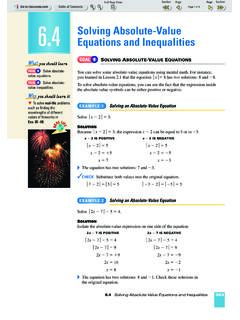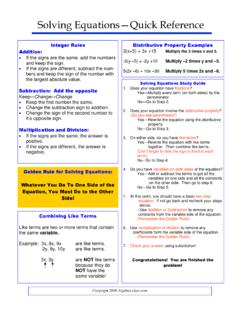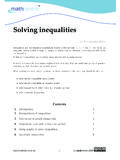Transcription of A Quick Algebra Review - Hood College
1 A Quick Algebra Review 1. Simplifying Expressions 2. solving equations 3. Problem solving 4. Inequalities 5. absolute Values 6. Linear equations 7. Systems of equations 8. Laws of Exponents 9. Quadratics 10. Rationals 11. Radicals Simplifying Expressions An expression is a mathematical phrase. Expressions contain numbers and variables, but not an equal sign. An equation has an equal sign. For example: Expression: Equation: 5 + 3 5 + 3 = 8 x + 3 x + 3 = 8 (x + 4)(x 2) (x + 4)(x 2) = 10 x + 5x + 6 x + 5x + 6 = 0 x 8 x 8 > 3 When we simplify an expression, we work until there are as few terms as possible. This process makes the expression easier to use, (that s why it s called simplify ).
2 The first thing we want to do when simplifying an expression is to combine like terms. For example: Now you try: x + 5x + 3x + x - 5 + 3 [You should get x + 4x + 5x 2] Order of Operations PEMDAS Please Excuse My Dear Aunt Sally, remember that from Algebra class? It tells the order in which we can complete operations when solving an equation. First, complete any work inside PARENTHESIS, then evaluate EXPONENTS if there are any. Next MULTIPLY or DIVIDE numbers before ADDING or SUBTRACTING. For example: Inside the parenthesis, look for more order of operation rules - PEMDAS. We don t have any exponents, but we do need to multiply before we subtract, then add inside the parentheses before we multiply by negative 2 on the outside.
3 Simplify: -2[3 - (-2)(6)] = -2[3-(-12)] = -2[3+12] = -2[15] = -30 Simplify: x + 10x 6 5x + 4 = x + 5x 6 + 4 = x + 5x 2 There are many terms to look at! Let s start with x . There are no other terms with x in them, so we move on. 10x and 5x are like terms, so we add their coefficients together. 10 + (-5) = 5, so we write 5x. -6 and 4 are also like terms, so we can combine them to get -2. Isn t the simplified expression much nicer? Let s try another Practice makes Now you try: 2x + 4 [2 (5x 3)] [you should get -18x +20] Simplify: (-4)2 + 2[12 + (3-5)] = (-4)2 + 2[12 + (-2)] = (-4)2 + 2[10] = 16 + 2[10] = 16 + 20 = 36 Inside the parenthesis, look for order of operation rules - PEMDAS.
4 We need to subtract 5 from 3 then add 12 inside the parentheses. This takes care of the P in PEMDAS, now for the E, Exponents. We square -4. Make sure to use (-4)2 if you are relying on your calculator. If you input -42 the calculator will evaluate the expression using PEMDAS. It will do the exponent first, then multiply by -1, giving you -16, though we know the answer is 16. Now we can multiply and then add to finish up. Simplify: (5a2 3a +1) (2a2 4a + 6) = (5a2 3a +1) 1(2a2 4a + 6) = (5a2 3a +1) 1(2a2) (-1)(- 4a )+(-1)( 6) = (5a2 3a +1) 2a2 + 4a 6 = 5a2 3a +1 2a2 + 4a 6 = 3a2 + a - 5 Since there are no like terms inside the parenthesis, we need to distribute the negative sign and then see what we have.
5 There is really a -1 there but we re basically lazy when it comes to the number one and don t always write it (since 1 times anything is itself). So we need to take -1 times EVERYTHING in the parenthesis, not just the first term. Once we have done that, we can combine like terms and rewrite the expression. solving equations An equation has an equal sign. The goal of solving equations is to get the variable by itself, to SOLVE for x =. In order to do this, we must undo what was done to the problem initially. Follow reverse order of operations look for addition/subtraction first, then multiplication/division, then exponents, and parenthesis. The important rule when solving an equation is to always do to one side of the equal sign what we do to the other.
6 For example Your Turn: 2(x -1) = -3 (you should get x = -1/2) Solve: x + 9 = -6 -9 -9 x = -15 To solve an equation we need to get our variable by itself. To move the 9 to the other side, we need to subtract 9 from both sides of the equal sign, since 9 was added to x in the original problem. Then we have x + 9 9 = -6 9 so x + 0 = -15 or just x = -15. Solve: 5x 7 = 2 +7 +7 5x = 9 5x = 9 5 5 x = 9/5 When the equations get more complicated, just remember to undo what was done to the problem initially using PEMDAS rules BACKWARDS and move one thing at a time to leave the term with the variable until the end. They subtract 7; so we add 7 (to both sides).
7 They multiply by 5; we divide by five. Solve: 7(x + 4) = 6x + 24 distribute 7x + 28 = 6x + 24 -28 - 28 7x = 6x - 4 -6x -6x x = -4 When there are variables on both sides of the equation, add or subtract to move them to the same side, then get the term with the variable by itself. Remember, we can add together terms that are alike! Problem solving Many people look at word problems and think, I m really bad at these! But once we accept them, they help us solve problems in life when the equation, numbers, and variables are not given to us. They help us THINK, logically. One of the challenging parts of solving word problems is that you to take a problem given in written English and translate it into a mathematical equation.
8 In other words, we turn words into numbers, variables, and mathematical symbols. There are three important steps to translating a word problem into an equation we can work with: Let s look at an example: The fence around my rectangular back yard is 48 feet long. My yard is 3ft longer than twice the width. What is the width of my yard? What is the length? First, we have to make sure we understand the problem. So what s going on here? Drawing a picture often helps with this step. length width 1. Understand the problem 2. Define the variables 3. Write an equation Yard We know that the problem is describing a person s rectangular yard. We also know that one side is the width and the other side is the length.
9 The perimeter of (distance around) the yard is 48ft. To arrive at that perimeter, we add length + length + width + width, or use the formula 2l + 2w = p (l = length, w = width, p = perimeter) Next, we have to define the variables: We know the perimeter is 2w + 3 48ft, but we do not know the length or width of the yard. Let s have w = the width. We find the length by multiplying the width by 2 and adding 3, so length = 2w + 3. Let s add these labels to the picture. Now, we write an equation. p = 2l + 2w 48 = 2(2w + 3) + 2w To solve the equation: 48 = 2(2w + 3) + 2w 48 = 4w + 6 + 2w 48 = 6w + 6 -6 -6 42 = 6w 6 6 7ft = w=width The problem also states, The length of my yard is 3ft more than twice the width.
10 This means that if I know the width, I can multiply it by 2 and add 3 to determine the length. Yard To write the equation we substitute our variables into the equation for the perimeter. The formula already calls for w, so we can just leave that as is. Where it calls for length, we can just plug in 2w + 3 . We already know our perimeter is 48ft, so we substitute that in for p. Use the distributive property to multiply 2 by 2w and 3. Combine like terms (4w and 2w). Subtract 6 from both sides to undo the addition. Divide by 6 on both sides to undo the multiplication. You are left with a width of 7 ft. Now we need to find the length. w Check to see that it works 2(7) + 3 14 + 3 17ft = length Your turn: I have a box.









